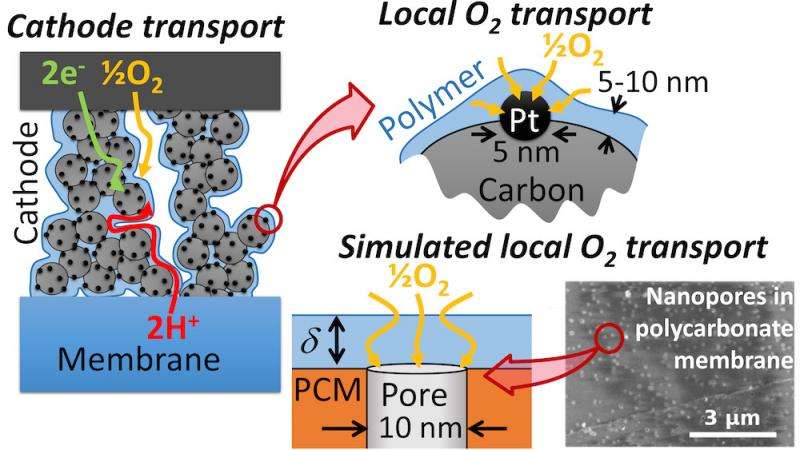Researchers rule out potential cause of resistance in polymer electrolyte fuel cells

Researchers at Carnegie Mellon University have discovered how nanoscale polymer films limit future cost reductions in fuel cell electric vehicles, findings that will guide future research and development efforts.
The results were reported in an article titled "Gas Transport Resistance in Polymer Electrolyte Thin Films on Oxygen Reduction Reaction Catalysts," published in the journal Langmuir by Associate Professor of Mechanical Engineering Shawn Litster, Hang Liu and William Epting.
Polymer electrolyte fuel cells (PEFCs) are a promising option for electric vehicles due to their high power density, long driving range, quick refueling and zero carbon tailpipe emissions. Hydrogen fuel is derived primarily from reformed natural gas, but can also be produced from renewable electricity and water (through electrolysis).
Unfortunately these fuel cells still require the use of an expensive material—platinum—as the cathode catalyst, the place where the fuel cell combines oxygen (from the air) with protons and electrons extracted from the hydrogen fuel at the anode, producing the water exhaust. The large amount of platinum for the cathode forces the cost of the vehicle to be higher than most consumers would be willing to pay.
The key to lowering the cost is to reduce the amount of platinum. But as industry and researchers attempt to do this, they encounter a previously-neglected resistance in the cathode that prevents further platinum reductions.
In trying to resolve this resistance, significant debate has emerged as to its origin. Researchers agree that polymer electrolyte films that are only tens of nanometers thick are in some way responsible. These films provide the proton transport for the electrochemical reaction and bind the electrode together.
"There have been two main hypotheses to explain this resistance, one focusing on reduced oxygen permeability in nanoscale films and the other on electrolyte poisoning of the catalyst," said Litster.
"Some researchers put forth that changes in the polymer electrolyte's structure (as it's made very thin) could restrict oxygen transport, causing unexpectedly high resistances. The second hypothesis is based on the electrolyte's acid adsorbing, or "sticking," to the platinum surface, blocking it from performing the desired reactions."
Litster's team set out to test these hypotheses by separating the platinum from the polymer and measuring the film's oxygen transport resistance independently. (Previous studies have measured the resistance while the polymer was in contact with the platinum catalyst.) The team achieved this by supporting the thin polymer films on inert nano-porous polymer membranes.
During their experiments, they found no dramatic change in the transport properties as they moved to films as thin as 30 nanometers.
"This gives us strong evidence that the origin of the resistance is the electrolyte acid's interaction with the platinum," said Litster.
Moving forward, this result will direct research and development efforts to address the problem of the electrolyte acid's interaction with the platinum instead of focusing on the oxygen transport properties. The goal will be to accelerate the commercialization of fuel cell electric vehicles.
Litster runs the Laboratory for Transport Phenomena in Energy Systems at Carnegie Mellon University where his team researches sustainable energy technologies and their applications, including fuel cells, batteries, supercapacitors and CO2 capture technologies.
Journal information: Langmuir


















